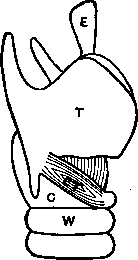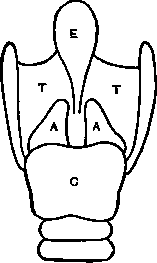Voice Training In Speech And Song - online tutorial
The Structure And Use Of The Vocal Organs, And The Means Of Securing Distinct Articulation.
| Share page | Visit Us On FB |
|
THE VIBRATORY APPARATUS. |
9 |
|||
|
forming Adam's apple. The two vocal cords are attached at their front ends into this angle. Just above the cords the epiglottis is attached (Fig. 3). The wings of the thyroid are widely separated behind and are prolonged into two horns, one of which passes upwards to join the hyoid (the tongue bone), and the other passes downwards to join the cricoid (Fig. 3). |
||||
|
|
||||
 |
 |
|||
|
|
||||
|
Fig. 2.—The Larynx.
Situated at the top of W, the Windpipe, upper opening guarded by E, Epiglottis; T, Thyroid Cartilage; C, Cricoid Cartilage. The muscle passing from the Cricoid to the Thyroid is called the Crico-Thyroid muscle. |
Fig. 3.—Back View of Larynx.
Showing the signet-ring C, Cricoid Cartilage, surmounted by A, the two Arytenoid Cartilages; T, Thyroid Cartilage, open at the back; E, Epiglottis. |
|||
|
15. The Vocal Cords.—The vocal cords consist of muscle and yellow elastic tissue covered with mucous membrane; they can be stretched or relaxed by altering the position of the cartilages to which they are attached. They are triangular in shape, with their bases attached to the thyroid and their edges free (Fig. 5). They stretch from the |
||||